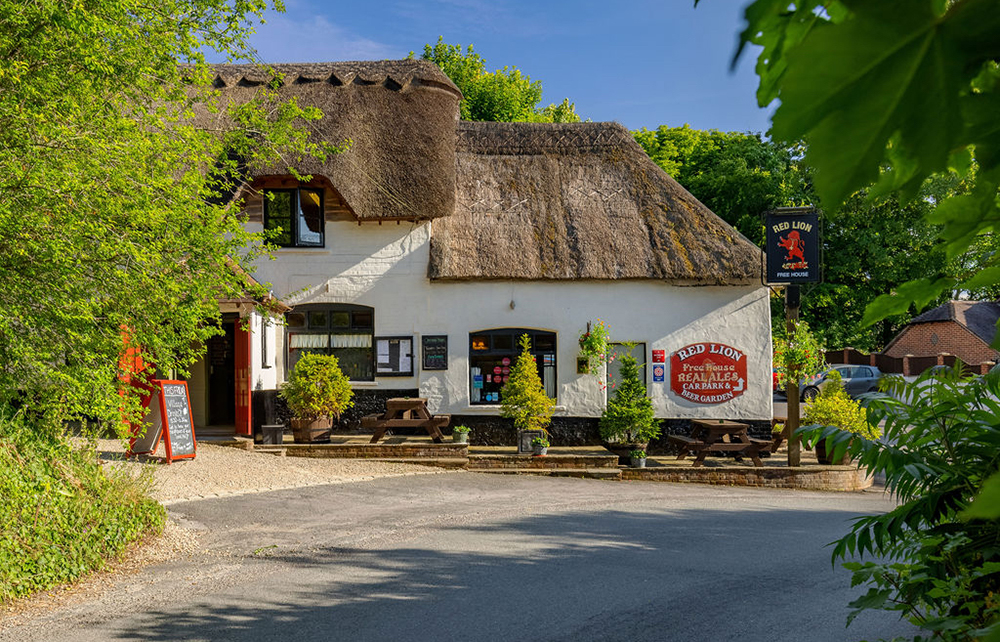The Red Lion, East Chisenbury, is in the Pewsey Vale on the edge of Salisbury Plain. Wiltshire’s strangeness surpasses even Cornwall and its menhirs: it has the greater volume of ghosts. I once spent an eerie day in Imber, the deserted village on the plain – the inhabitants were given 47 days’ notice to leave in November 1943, so American soldiers could shoot up Imber in preparation for invading Normandy. Its church of St Giles, perfectly maintained, is open one day a year in September. Its pub, the Bell Inn, was sold to the Ministry of Defence, and is not a fine restaurant with rooms but a red-brick ruin, with the glass of the windows shot out: Daphne du Maurier’s ideal, the Manderley of pubs.
The Red Lion, though, is alive and looks normal: it is long, wonky, charming and thatched. My companion says you can’t thatch buildings for 30 years these days: the straw is of insufficient quality. (This is his obsession.) There is a preening red lion on an exterior wall, and a car park in which people jostle for space in some great metaphor for the state of rural housing.
It’s busy on a weekday lunchtime with retirees who forgot to return to work after Covid
Wiltshire is the native land of pigs, ghosts – the real Wolf Hall is here, unrenovated and fascinating – and moon-rakers: locals told customs men they were looking for the moon in the pond when caught retrieving goods, and customs men believed them, which is offensive. (My husband is a Wiltshire man, a moon-raker, and he thinks lardy cake, which should be bought from the award-winning Marshalls in Pewsey, is a cake, though it isn’t. It’s a bread which his father ate daily, and in secret.) But this is the soft and monied part. When I googled East Chisenbury, the results were all of house prices, which are high. It is close enough to London for fashionable people to live here, yet it is not the violently repointed Cotswolds: it is more sombre and interesting. But you can sense the money in the groups of gardeners, who stand in the road.
The Red Lion has a famous restaurant, and rooms to sleep in – the hotel part is called the Troutbeck – but it is still, crucially, a real pub. (The restaurant-pub in my village discourages mere alcoholics for people seeking seafood platters.) A pickled egg is £1; a Scotch egg £3.

Since 2008 it has been owned by Guy and Brittany Manning, and it is busy on a weekday lunchtime with retirees who forgot to return to work after Covid, and families taking ancient parents to lunch to celebrate their survival. It is not immolated in Farrow & Ball or assembled from parts of a lost manor house: it is not over-artful. It has plain stone floors and exposed brickwork; a wood-burner; pleasing flowers; a blackboard. To come here – and you should if you want to navigate Wiltshire’s ghosts – you must book ahead.
We order a crab tart and a Scotch egg; a dish of venison, and another of scallops; a jambonette and some fennel ice cream for pudding. It is not cheap: the main courses are £30 or so. But it is as good as pub food – I wince typing the word gastropub, and only do it to warn of the danger to language of all marketing drivel – gets. The Scotch egg is fierce and heavy. The jambonette is a warm salad of pig. The venison sits on a brick of a chip. This food has balance: it is loved. When the bill comes, I realise that coffee is more expensive than beer in the Pewsey Vale, and I am charmed.
The Red Lion, East Chisenbury, Pewsey, SN9 6AQ; 01980 671124.






Comments